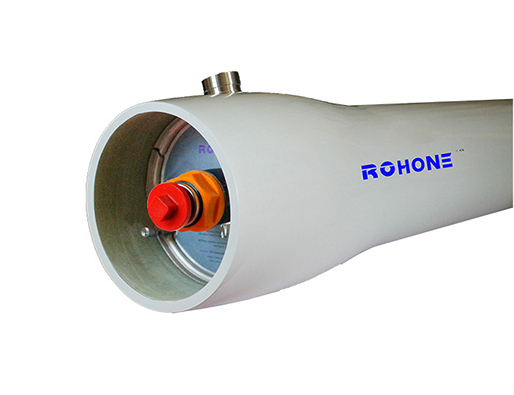Reverse osmosis membrane housings are the key system for producing pure water. The reverse osmosis membrane housings are designed for safe and stable operation of the reverse osmosis system. According to the performance of the reverse osmosis membrane element, the pressure vessel is divided into a low-pressure pressure vessel to ensure that it is sealed, non-toxic, non-polluting, and meets the requirements of long-term use and non-corrosion.
The materials used for the reverse osmosis membrane shell are mainly glass fiber reinforced plastic, stainless steel, engineering plastics, etc., and the application working pressure range is usually in the middle and high-pressure situations and the glass fiber reinforced plastic is mainly used. After the water enters the membrane element in the reverse osmosis membrane shell, the water molecules or trace ions and small molecules in the water will enter the permeate through the ultra-thin barrier of the membrane, and enter the intermediate pure water tank after passing through the collection pipe. On the contrary, the concentrated water that cannot pass through the reverse osmosis membrane shell is discharged out of the system through the discharge pipe.
At present, the reverse osmosis membrane shell for reverse osmosis water treatment in the world is mainly glass fiber reinforced plastic, and almost all large-scale and key projects use glass fiber reinforced plastic pressure vessels. The structure design of the reverse osmosis membrane shell has undergone strict layup design and optimized calculation details on the barrel body, head, and slot of the membrane shell to ensure structural safety and ensure the safety and stability of the structure under long-term pressure. Optimized the design of the concentrated water side opening, which can meet the necessary safety pressure for opening four side openings on one head, and strengthen the variability in the installation process.

Reverse Osmosis Membrane Housings
The difference between the feed water pressure of the reverse osmosis membrane shell and the pressure of the concentrated water outlet of the reverse osmosis pressure vessel. In the management of reverse osmosis equipment, the pressure difference generated by a pressure vessel is generally used as an operation management monitoring item. The differential pressure is an index indicating the degree of resistance to the flow of water in the R/O pressure vessel. If the pressure difference increases under a certain flow condition, it indicates that the water flow channel in the membrane element is blocked to a certain extent.
In fact, the reverse osmosis membrane shell reflects the influence of many variables such as the water quality, flow rate, and temperature changes of the feed water and concentrated water during operation. Therefore, it is more difficult to accurately compare the pressure difference changes reflected by the reverse osmosis membrane shell at various times.
Installation steps of reverse osmosis membrane pressure vessels
1. Identify according to the product accessory pattern, use saddles and straps to fix the membrane shell horizontally on the equipment support. The strap fixing bolts should not be too tight, leave a certain amount of room for expansion, and leave appropriate space for the left and right connectors.
2. Remove the parts in the membrane shell, and clean each part and the inner wall of the shell with water or neutral lotion.
3. Use an appropriate amount of food-grade glycerin to apply glycerin evenly on the sealing plate, the outside of the adapter O-ring, and the inner end of the groove at the end of the membrane shell, which is conducive to the installation of membrane elements. When installing the last section of the filter membrane, please do not push it too deep. Install the thrust ring and end assembly on the concentrated waterside, and push the membrane module firmly from the inlet side to the concentrated waterside.
3. Put the three crescent-shaped retaining rings into the end groove of the reverse osmosis membrane shell, align the screw holes, and lock the screws with an Allen key.